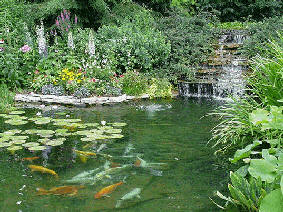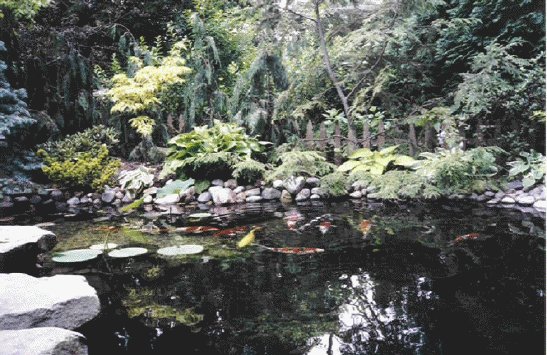Fish Pond Building Info
Fish Pond Supplies and Information About Fish Ponds
To begin, you will need to start planning your fish pond project. This begins with selecting it's location. Ideally, the pond should be visible from the house where you frequent the most. This may be off your kitchen, grateroom, and viewable from your patio area where it can be enjoyed from inside your home as well as outside. Spend some time thinking of where the best location may be.
Some fish pond owners choose an area of their yard where it has a natural slope and a place where there is a bit of shade. This can be ideal for large fish ponds but has its drawbacks, too.
Having an ample amount of shade can make your fish pond more enjoyable. The leaves from the nearby trees can however, add nutrients that's needed for algae to grow - so, shade can be a double-edged sword. Tree roots can also puncture pond liners or those sealed with bentonite clay. Yet, sitting and enjoying your new water feature under a bit of shade can make the experience more relaxing and enjoyable. So, it becomes a personal choice where to locate your pond.
 |
Locating your fish pond at the bottom of a hill also has it's drawback as the rain water, along with any fertilizers and chemicals that are sprayed on the surrounding landscape uphill, will inadvertently wash into your pond. These chemicals can be toxic to any fish and can encourage the growth of algae and pond weeds. In this case, a french drain would be ideal to have installed around the perimeter where run-off from the fertilizers and chemicals used uphill can be collected via the french drain and diverted to a different area other than going into your fish pond.
The type of fish one chooses to raise will also be one of the things to consider before excavating begins. Fish such as trout require ponds at least ten feet deep as they like cooler water temperatures in the deeper areas. Koi and goldfish ideally need ponds at least 3' deep, if not deeper, to withstand cold winter months. Often times pond enthusiasts will have a koi pond with goldfish and mosquitofish. Some, might add a small catfish or two. Beware though, in this type of pond you may have many cross bred fish and can very quickly have too many fish for your size of water feature and the filtration system you have set up. |
The shape of your fish pond and style will be other decisions you'll make. While we have a complete Build a Pond ebook course for creating fish ponds and water gardens, a brief overview would be to outline the pond with a garden hose (works best) or rope. If you're building a small fish pond (less than 50' x 50' in size), take into consideration that you'll most likely line it with rocks. You may want to choose your rocks first so you can allow for the depth of the rocks plus the depth of the water. So, if the outer area of your pond is suposed to be 4 - 6" deep for marginal plants and you plan on using rocks that are about 4 - 5" thick, you'll need to excavate this area 8 - 11" area, or therabouts, to accomodate the size of the rocks. More about that in our build a pond ebook course...
| When goldfish are concerned, a goldfish pond should be at least 3' deep to avoid freezing in the winter. One that is shallower than that can make the it easier to clean, etc. but the fish ideally need it deeper.
Koi are larger fish and therefore, need more room. Fish ponds designed to accommodate koi fish should always be at least 3' deep, if not even 4 or 5' deep. This gives the koi not only horizontal space to swim in but vertical space as well which gives them an even, muscular tone. Besides the providing muscle tone from ponds that are deeper, the depth of the fish pond also has different temperature zones and oxygen levels. Pond fish, like water temperatures more consistent instead of going from hot water to cooler water and back to hot again. The surface of the water presents more oxygen but higher water temperatures whereas the deeper areas area cooler but has less oxygen. |
 |
It's always best to have a deeper fish pond for more reasons what I've even just mentioned and have a Diffused Aerators installed. This will give oxygen to the fish at the bottom where they are most comfortable. Make sure there is ample room for the fish in this deeper section, too as the outside shelves that are as deep as 18 - 24", will probably be filled with pond plants. Large, Japanese koi will be especially thankful to you for this large, deep area.
Every fish pond should have the best filtration you can afford. If you have a smaller pond (less than 50' x 50' in size) you will need a good Pond Filters. We cover this topic in detail in our build a pond ebook course. If you have a large fish pond that is over 50' x 50' in size, you typically don't need a filter because you have more water volume and it's not practical to filter that large volume of water. What you do then, is make sure you have a pond aerator and use beneficial bacteria on a regular basis. This acts as your pond filter.
 |
When you dig your fish pond, you will need to create 3 different levels if you plan on having plants in the pond. The first level in the outermost area of the pond is the shallowest area that should be approximately 6" deep. This area in the pond is referred to as the bog shelf and certain plants grow at this depth. The next shelf within the garden fish pond needs to be approx. 18 - 24" deep. This area in the garden pond is referred to as the marginal shelf. This is where water lilies and other marginal plants grow. Each shelf within the water garden or fish pond should be at least 12" wide, if not 18" or so. Then, the middle area should be the deepest. The pond fish will enjoy being at this depth. You won't want to plant anything in this deep area. For fish ponds that are long and narrow, you may consider the bog and marginal shelves at one end and the deepest area of the pond at the opposite end. |
Fish ponds do require maintenance. Typically, if you have an adequate size of filter, use beneficial bacteria on a regular basis and do what you can to eliminate an overpopulation of fish and an abundance of organic matter from building up in the pond, then you've done half the battle.
Fish ponds will require some type of oxygenation, too. This can be best achieved by a diffused pond aerator which is super easy to install and can and should be used all year long. We carry all of these fish pond supplies mentioned above along with thousands of other pond products. Naturally, we have complete, do it yourself, pond kits, too that make shopping for the pond supplies you need easy as the pond kits come with everything you want to build a pond the right way.
For more information, please check out our How-To Guide, FAQs, our Build a Pond ebook or contact us with your questions. We're happy to help you! :)
